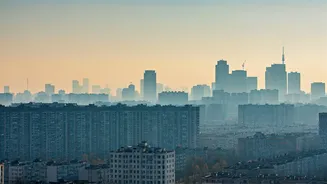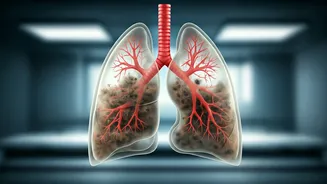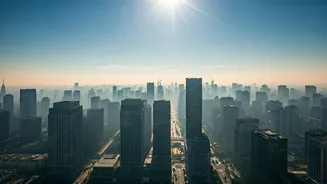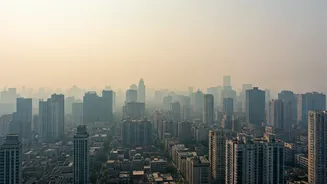Smoggy Skies Above
The air quality in Delhi has deteriorated, becoming a major health concern for its inhabitants. The Air Quality Index (AQI) readings have climbed to nearly
380, placing the city within the 'very poor' category. This level of pollution can pose serious risks, particularly for those with existing respiratory ailments, the elderly, and children. The widespread smog is visible across the city, reducing visibility and exacerbating discomfort. Despite various measures to curb pollution, including the implementation of the Graded Response Action Plan (GRAP-3), the situation remains critical. The persistence of poor air quality raises questions about the effectiveness of current pollution control strategies and the long-term implications for public health.
Health and Hazards
The 'very poor' air quality in Delhi significantly impacts public health. Extended exposure to high levels of pollutants can trigger a range of health issues, including breathing difficulties, aggravated asthma, and increased susceptibility to respiratory infections. Furthermore, long-term exposure can lead to chronic diseases. The fine particulate matter in the air, often referred to as PM2.5, can penetrate deep into the lungs and even enter the bloodstream, causing systemic inflammation. Authorities have issued warnings, advising vulnerable populations to limit outdoor activities and use protective measures like air purifiers. These warnings underscore the immediate dangers posed by the current air quality and the need for prompt action to mitigate health risks.
Addressing the Crisis
To combat the worsening air pollution, the authorities have implemented measures such as the Graded Response Action Plan (GRAP-3). However, even with these actions, the air quality remains a concern, indicating the complexity of the challenge. Effective solutions require a combination of short-term and long-term strategies. In the short term, this may involve stricter enforcement of pollution control measures, such as regulating construction activities and controlling vehicular emissions. Long-term strategies necessitate a comprehensive approach, including transitioning to cleaner energy sources, promoting sustainable transportation, and improving waste management practices. Addressing the pollution requires collaborative efforts from government bodies, industries, and the public, all working together to improve air quality.
Looking Ahead
Delhi's air pollution crisis serves as a stark reminder of the urgent need for consistent efforts to ensure environmental health. The situation demands a shift towards sustainable practices and a commitment to safeguarding public health. Monitoring air quality levels, raising public awareness, and ensuring accountability for polluters are essential steps toward building a healthier future. The success of future actions will hinge on political will, community engagement, and the implementation of efficient, integrated strategies to reduce air pollution and its adverse consequences. Ultimately, the goal is to create a livable environment where Delhi's residents can breathe clean air, enjoy better health, and live with peace of mind.

















